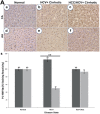Genomic variants link to hepatitis C racial disparities
- PMID: 28938650
- PMCID: PMC5601746
- DOI: 10.18632/oncotarget.19755
Genomic variants link to hepatitis C racial disparities
Abstract
Chronic liver diseases are one of the major public health issues in United States, and there are substantial racial disparities in liver cancer-related mortality. We previously identified racially distinct alterations in the expression of transcripts and proteins of hepatitis C (HCV)-induced hepatocellular carcinoma (HCC) between Caucasian (CA) and African American (AA) subgroups. Here, we performed a comparative genome-wide analysis of normal vs. HCV+ (cirrhotic state), and normal adjacent tissues (HCCN) vs. HCV+HCC (tumor state) of CA at the gene and alternative splicing levels using Affymetrix Human Transcriptome Array (HTA2.0). Many genes and splice variants were abnormally expressed in HCV+ more than in HCV+HCC state compared with normal tissues. Known biological pathways related to cell cycle regulations were altered in HCV+HCC, whereas acute phase reactants were deregulated in HCV+ state. We confirmed by quantitative RT-PCR that SAA1, PCNA-AS1, DAB2, and IFI30 are differentially deregulated, especially in AA compared with CA samples. Likewise, IHC staining analysis revealed altered expression patterns of SAA1 and HNF4α isoforms in HCV+ liver samples of AA compared with CA. These results demonstrate that several splice variants are primarily deregulated in normal vs. HCV+ stage, which is certainly in line with the recent observations showing that the pre-mRNA splicing machinery may be profoundly remodeled during disease progression, and may, therefore, play a major role in HCV racial disparity. The confirmation that certain genes are deregulated in AA compared to CA tissues also suggests that there is a biological basis for the observed racial disparities.
Keywords: alternative splicing; genomic variants; hepatitis C; hepatocellular carcinoma; racial disparity.
Conflict of interest statement
CONFLICTS OF INTEREST The authors declare that they have no conflicts of interest.
Figures



Similar articles
-
Quantitative proteomic analysis in HCV-induced HCC reveals sets of proteins with potential significance for racial disparity.J Transl Med. 2013 Oct 1;11:239. doi: 10.1186/1479-5876-11-239. J Transl Med. 2013. PMID: 24283668 Free PMC article.
-
Differential Expression of MicroRNAs in Hepatitis C Virus-Mediated Liver Disease Between African Americans and Caucasians: Implications for Racial Health Disparities.Gene Expr. 2017 Feb 10;17(2):89-98. doi: 10.3727/105221616X693594. Epub 2016 Oct 19. Gene Expr. 2017. PMID: 27765085 Free PMC article.
-
Activation of fetal promoters of insulinlike growth factors II gene in hepatitis C virus-related chronic hepatitis, cirrhosis, and hepatocellular carcinoma.Hepatology. 1996 Jun;23(6):1304-12. doi: 10.1002/hep.510230602. Hepatology. 1996. PMID: 8675143
-
Hepatitis C virus in chronic liver disease and hepatocellular carcinoma in Taiwan.Princess Takamatsu Symp. 1995;25:27-32. Princess Takamatsu Symp. 1995. PMID: 8875606 Review.
-
Coinfection of Schistosoma Species with Hepatitis B or Hepatitis C Viruses.Adv Parasitol. 2016;91:111-231. doi: 10.1016/bs.apar.2015.12.003. Epub 2016 Feb 5. Adv Parasitol. 2016. PMID: 27015949 Review.
Cited by
-
Role of hepatocyte nuclear factor 4-alpha in gastrointestinal and liver diseases.World J Gastroenterol. 2019 Aug 14;25(30):4074-4091. doi: 10.3748/wjg.v25.i30.4074. World J Gastroenterol. 2019. PMID: 31435165 Free PMC article. Review.
-
Assessment of risk factors, and racial and ethnic differences in hepatocellular carcinoma.JGH Open. 2020 Apr 15;4(3):351-359. doi: 10.1002/jgh3.12336. eCollection 2020 Jun. JGH Open. 2020. PMID: 32514436 Free PMC article. Review.
-
Virus-Host Protein Interaction Network of the Hepatitis E Virus ORF2-4 by Mammalian Two-Hybrid Assays.Viruses. 2023 Dec 12;15(12):2412. doi: 10.3390/v15122412. Viruses. 2023. PMID: 38140653 Free PMC article.
References
-
- Jacobson IM, Davis GL, El-Serag H, Negro F, Trépo C. Prevalence and challenges of liver diseases in patients with chronic hepatitis C virus infection. Clin Gastroenterol Hepatol. 2010;8:924–33. - PubMed
LinkOut - more resources
Full Text Sources
Other Literature Sources
Miscellaneous

